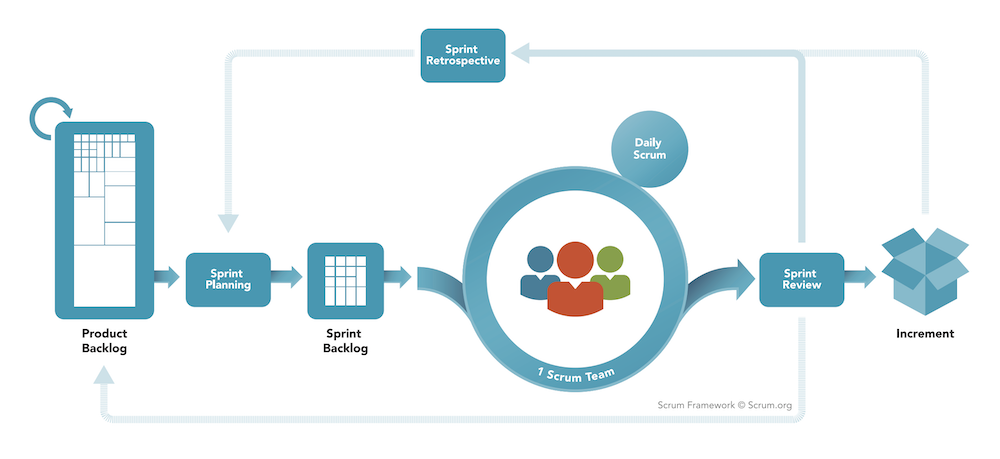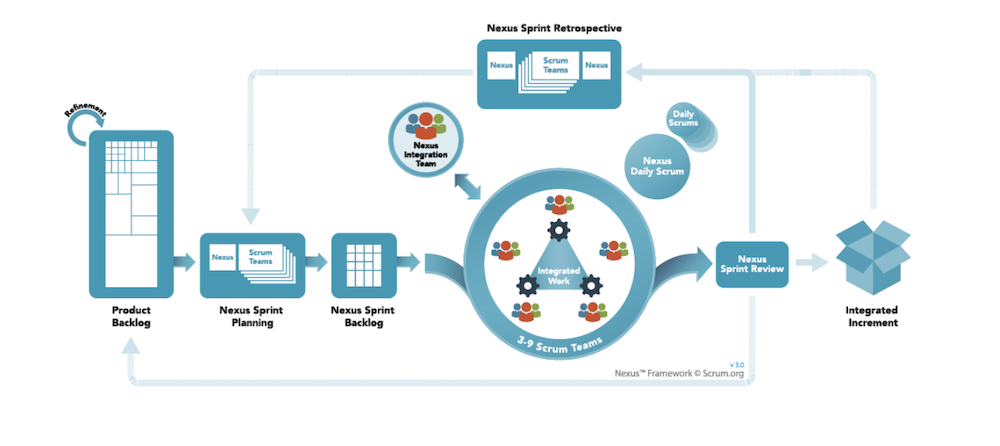So it’s done. After several weeks of reading a 19-page PDF file over and over, taking practice tests and reading countless blog posts, you can now, officially, call me master. Scrum Master. I got certified!
I’d have thought that would have come from the day job, where I work on two Scrum teams, but studying for the PSM1 Scrum Master certification actually underlined how little I knew about the guidelines of this process. Sorry, that should be more properly: the rules, roles, events and artefacts of this empirical framework.
 The Scrum Framework
The Scrum Framework
I passed pretty comfortably in the end, but found the 60-minute exam on scrum.org quite nerve-wracking, especially as the $150 fee I’d paid to take it is non-refundable, and is only good for one try. (I thought .org was for non-profit making companies?)
But I’m happy to have been through the process, and have already used quite a lot of what I learned in the day job. While Scrum Master and Delivery Manager - my current job role - are by no means a perfect fit, and I’ll have more to say on that later, it’s still very useful to have a clear grounding in “the rules of the game”. Here are a few tips for anyone who wants to do the same:
Practice, practice, practice
The Scrum Guide itself is pretty short, coming in at around 15 pages of the good stuff, if you chop out the intro and thank-yous at the beginning and end. But the rest is very information-dense, and the 60 questions on the final exam could be on literally any paragraph of the guide.
For me, who hasn’t done any exams for a decade (and took three tries to pass that one - NCTJ media law, for my past life as a journalist), I found it very hard going to study and memorise.
Luckily, there are loads of practice tests out there that you can use to get clearer on the key concepts: scrum.org itself uses Open Assessments that have 30 questions, but I made heavier use of Mikhail Lapshin’s (awesome) 87-question test set, which more closely mirrors the actual experience of the exam.
Being obsessively routine-driven, in the week leading up to my planned exam slot, I did Lapshin’s practice test each morning before work, and only gave myself the go-ahead for the exam when I got 100% two days in a row.
This might feel silly and repetitive, and the learning by rote a bit retrograde and non-creative, but I found it the most effective way to get me to remember the information. I can’t help but remember that “creativity” is one of the five Scrum values, but my hunger for the certificate overrode such scruples.
Close reading pays off
On the other hand, you will need to study the exact wording of the Guide very carefully to get all the questions in the exam right. Without wishing to reveal the exact questions in the exam, one good example is a practice question that asks for all the “formal” opportunities to inspect and adapt during the sprint.
The five possible answers - you can pick one or more - are the four main Scrum ceremonies (Daily Scrum, Review, Retrospective and Planning) plus the Sprint itself. You might think that as Scrum values continuous improvement as a guiding principle, that all five answers are correct. But the key word is “formal”: while you can inspect and adapt at any time, the correct answers are the (formal) ceremonies only. If you check the “Sprint” box, you fail the question.
Such tricky word-games might again seem antithetical to the spirit of Scrum - in my opinion at least - but you need to be wise to them to pass the exam.
Paradoxically, I found my academic background as an MA in literature helped me out here. Close reading of texts being probably the only applicable skill I can think of from my studies that continues to help me out in my career!
Caught in the Nexus
This one caught me a bit off guard when I got into the end stages of exam prep. Several questions on the exam are based not just on the Scrum Guide but on the Nexus Guide (refusing to put the trademark label in there, sorry guys but get a grip). This supplementary guide is for “scaling Scrum”: it gives guidelines at an organisation level for when there are several Scrum teams working on the same project.
I found these questions the hardest to prepare for, not least because the practice assessments aren’t as complete, so I had to read the PDF closely instead.
Nexus is also a vastly more complex set of rules, given its focus on cross-team cooperation and reducing dependencies and generation of technical debt between teams. This is definitely one of the hardest nuts to crack for digital teams these days, given that the extreme amount of transparency required is contrary to human nature, and also contrary to one of the nicest things about Scrum, which emphasises the value of a small, cross-functional, self-sufficient team.
In the real world, outside of the smallest companies, teams can’t be self-sufficient because they might throw up a whole bunch of dependencies for other teams that they don’t talk to on a day to day basis.
How applicable is the test in the real world?
The Nexus issue discussed above was probably the thing that increased my scepticism most about the value of the PSM1 exam.
The prevailing theme of the Scrum guide is that Scrum is a total methodology for product development: that if you miss any of the events, break any of the rules, or don’t fill all of the roles, not only are you not doing Scrum properly - you’re not doing Scrum at all.
That’s just about feasible within a single team - covered by the Scrum Guide. But, when you add Nexus in…? We’re in fantasy land, in my view. Look at the insane amount of meeting-based infrastructure in the Heath Robinson-esque diagram below. Particularly absurd is that the individual Scrum teams themselves are expected to function according to the Scrum Guide, and groom their own backlogs. When you layer in the Nexus backlog, Nexus sprints, and planning, and retrospective… to quote YouTube legend Sweet Brown, ain’t nobody got time for that.
 The Nexus Framework
The Nexus Framework
How many organisations are close to achieving Nexus nirvana? Certainly fewer than the number of users who actually take and pass this exam.
So yes, I’m not implementing all of what I learned in the exam in my day job. Which sucks in a way, but also makes me question the idea that if you are not following Scrum to the letter, you’re not doing Scrum. Particularly as the Scrum Guide itself has been revised over the years, and the Nexus guide was added at a much later date, I assume in response to criticism that the original guide wasn’t really applicable at org level.
So in other words, none of us is perfect, and we are all on a journey to improve. No totalising framework can govern how we get things done, but it can provide some useful guidance along the way. With that in mind, I’m happy I took the exam. Because it’s definitely helped me improve. And hopefully the personal payback for me will be worth well north of $150!